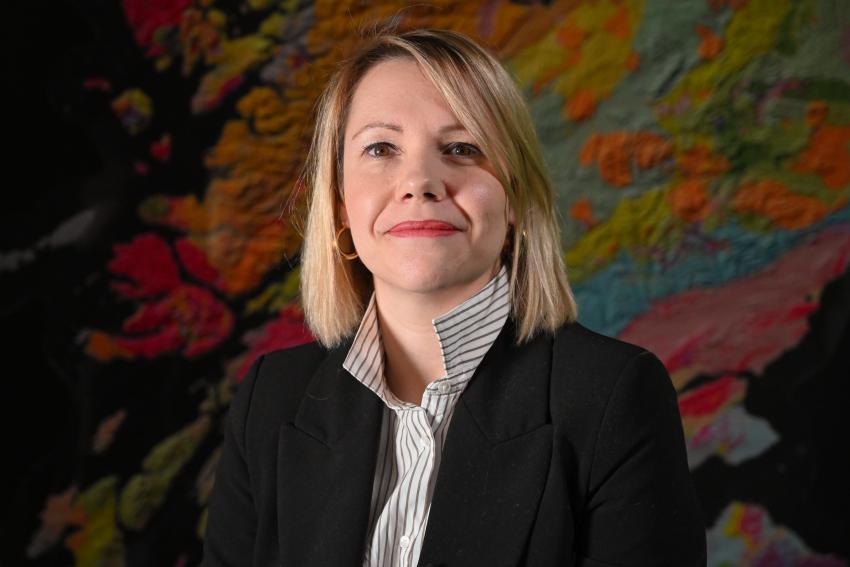A globally-renowned seismologist who has studied every major earthquake of the past 35 years has been appointed editor-in-chief of Geophysical Journal International (GJI), one of the world's leading peer-reviewed research journals in solid-Earth geophysics.
Dr Margarita Segou, of the British Geological Survey (BGS), is already a member of the journal’s editorial board but will succeed Jörg Renner as editor-in-chief from 1 March.
She called it an “honour” to be taking charge of “one of the most long-lived journals in Earth Sciences”.
“It is with humility and enthusiasm that I assume the role of editor-in-chief of the GJI journal of the Royal Astronomical Society,” Dr Segou said.
“I am taking the baton from Professor Renner, whom I respect deeply for his legacy and who will serve in my mind as an example of outstanding communication with members of the board and authors.”
GJI has been fully Open Access since 1 January 2024 - enabling everyone in the global community to have free, immediate, and unrestricted access to the high-quality research published within it.
It means authors are now charged a fee to publish their science, rather than the journal being supported by subscription fees.
“I am honoured to lead the editorial team at GJI in the Open Access era,” Dr Segou added.
"The challenges and opportunities that lie ahead for scientific journals will make an interesting story to tell.
“We will continue to publish exciting, groundbreaking science, honouring our diverse, international readership, while also transforming the communication of data and ideas among scientists.”
GJI publishes the results of research on the Earth's internal structure, physical properties, evolution and processes covering all aspects of theoretical, computational and observational geophysics.
Subjects include earthquake and controlled-source seismology, tides, the Earth's gravitational field in relation to its shape, deep interior, crustal structure, stress and isostasy; palaeomagnetism and rock magnetism; electromagnetism, rheology and volcanology.
The journal's mission is to promote understanding of the Earth's internal structure and physical properties, the processes operating in, on, and around it, and its evolution.
It is published by Oxford University Press on behalf of the Royal Astronomical Society and the Deutsche Geophysikalische Gesellschaft.
Dr Segou’s career accomplishments include applying state-of-the-art forecast models to estimate where and when aftershocks might take place following a major earthquake.
Her work on the grounds of the Central Apennines immediately after the 2016 Amatrice earthquake in Italy was acknowledged by the UK and Italian government as a paradigm of international scientific collaboration.
She has also recently been appointed as the first woman chair of the European Plate Observing System-Seismology.
After her dissertation at the University of Athens (NKUA), Dr Segou held postdoctoral positions and fellowships at the US Geological Survey (Menlo Park) and at GeoAzur-CNRS (Nice), before joining the BGS in 2015.
Her major interests include the physical processes of earthquake nucleation at different scales, involving short and long-term stress-mediated fault interaction.
Dr Segou’s research also addresses problems ranging from short-term subduction zone hazards, time-dependent seismic hazards, operational aftershock forecasts, earthquake probabilities and fault potentials in natural and induced seismicity cases by integrating complex physical and laboratory laws with existing empirical/statistical models.
Of her new role, she said: “Personally, I could never imagine back in graduate school, when we referred to GJI as the green one, that one day I would be called to serve as editor-in-chief.”
Media contacts
Sam Tonkin
Royal Astronomical Society
Mob: +44 (0)7802 877700
Robert Massey
Royal Astronomical Society
Mob: +44 (0)7802 877699
Margarita Segou
British Geological Survey
Tel: +44 (0)131 650 0291
Images and captions
Image: Margarita Segou
Credit: British Geological Survey
Caption: Margarita Segou, of the British Geological Survey, has been named the new editor-in-chief of Geophysical Journal International.
Notes for editors
About the Royal Astronomical Society
The Royal Astronomical Society (RAS), founded in 1820, encourages and promotes the study of astronomy, solar-system science, geophysics and closely related branches of science. The RAS organises scientific meetings, publishes international research and review journals, recognises outstanding achievements by the award of medals and prizes, maintains an extensive library, supports education through grants and outreach activities and represents UK astronomy nationally and internationally. Its more than 4,000 members (Fellows), a third based overseas, include scientific researchers in universities, observatories and laboratories as well as historians of astronomy and others.
The RAS accepts papers for its journals based on the principle of peer review, in which fellow experts on the editorial boards accept the paper as worth considering. The Society issues press releases based on a similar principle, but the organisations and scientists concerned have overall responsibility for their content.


